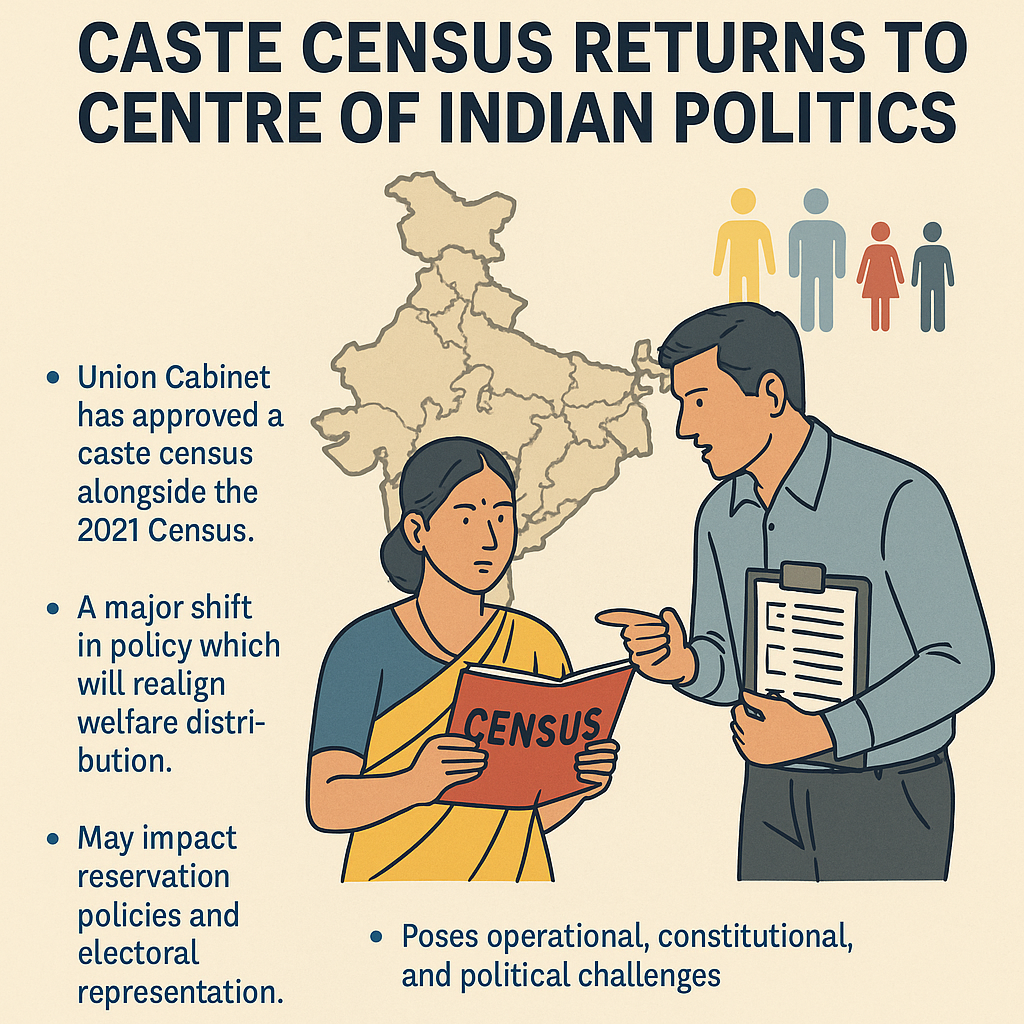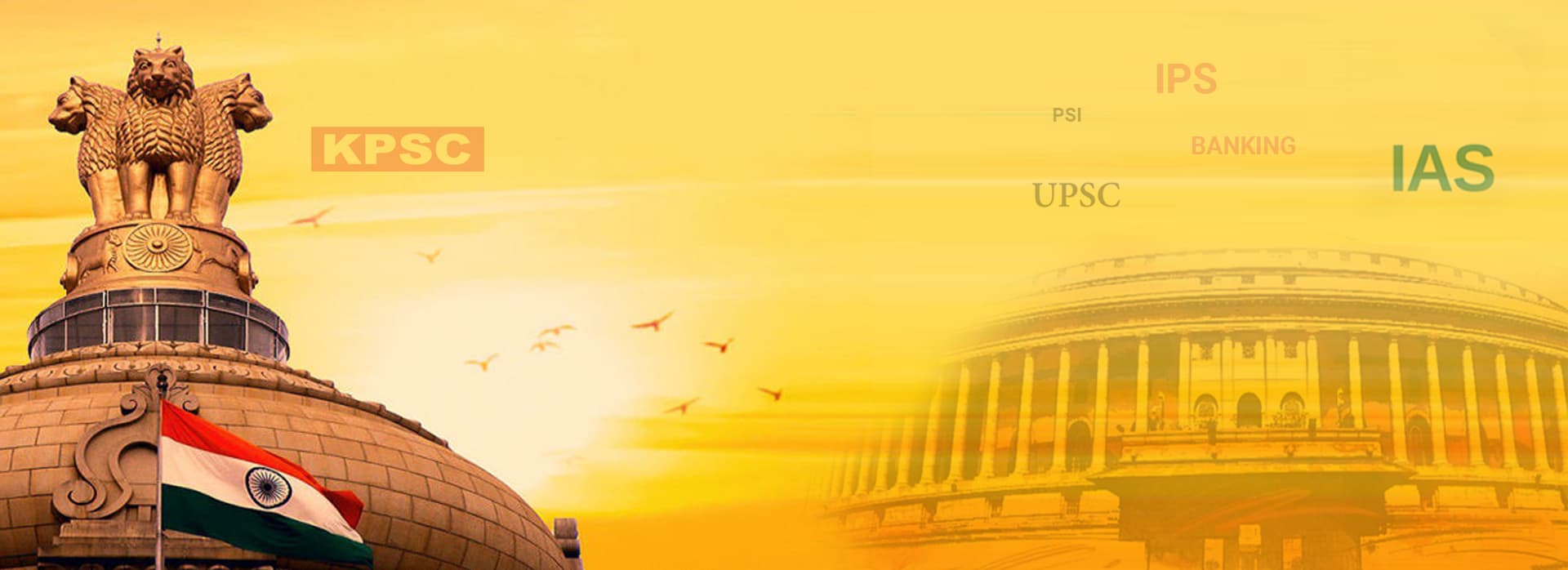Caste Census Returns to Centre of Indian Politics
Syllabus:
GS-1:
Population and Associated Issues
GS-2:
Government Policies & Interventions
Focus:
The Union Cabinet has approved a caste census to be conducted along with the delayed 2021 Census, marking a reversal from its earlier stance. This decision is expected to impact electoral boundaries, reservation policies, and political alignments, with far-reaching consequences for affirmative action and social justice frameworks.

Background and Historical Context:
Caste Census in Colonial and Post-Independence India
- The last comprehensive caste census was conducted in 1931 under British rule.
- The 1941 Census was incomplete due to World War II, and caste data was not published.
- After Independence, Indian governments deliberately excluded caste enumeration beyond SCs and STs, fearing it would entrench caste divisions.
- Since 1951, only Scheduled Castes (SCs), Scheduled Tribes (STs), and religious denominations were counted.
Shift in Ideological Approach Over Time
- Founding leaders believed caste enumeration would hinder caste eradication.
- Over decades, the rise of social justice politics and Mandal Commission recommendations in the 1990s changed this view.
- Demands grew stronger from states with Mandal legacy, especially Bihar and Uttar Pradesh.
Understanding Census in India:
●Conducted every 10 years since 1881, providing a systematic record of population and social changes.
● First Non-synchronous Census: Conducted in 1872 under Lord Mayo.
● First Synchronous Census: Held in 1881 under British rule
.
●Nodal Agency: Office of the Registrar General and Census Commissioner, under Ministry of Home Affairs.
Purpose & Importance
● Demographic Insight: Enumerates population size, distribution, literacy, employment, etc.
●Policy Formulation: Helps governments design targeted schemes based on real data.
●Social Change Mapping: Tracks changes in demographics, living standards, and mobility.
●Inequality Analysis: Identifies disparities across caste, gender, and region.
● Academic Resource: Used in research and planning across sectors.
About Caste Census:
● Involves caste-wise tabulation during the population count.
●SCs and STs have been counted since 1951.
●OBCs (52% population) remain uncounted, leading to repeated demands for caste enumeration.
●Last caste-based data: From 1931 Census (British India).
About the Census vs SECC (Socio-Economic Caste Census):
| Feature | Census | SECC |
| Legal Basis | Census Act, 1948 | No specific legal basis |
| Confidentiality | Strictly confidential | Used by government for benefit schemes |
| Frequency | Every 10 years | Conducted once in 2011 |
| Purpose | General demographic snapshot | Focus on economic condition and caste |
| First Conducted | 1881 (synchronous) | 2011, previously in 1931 (for caste) |
The Evolution of Political Standpoints:
The Congress Party’s Shift
- The Congress Party, once opposed to caste enumeration, shifted stance post-2019 electoral setback.
- Rahul Gandhi championed OBC representation and pushed for caste-based enumeration.
- Congress-led governments in Karnataka and Telangana undertook state caste surveys.
- It supported the Bihar caste survey when part of the Mahagathbandhan
The BJP’s Ideological Recalibration
- The BJP, influenced by the RSS, traditionally resisted caste census, viewing it as divisive for Hindus.
- Ahead of crucial elections (especially in Bihar), the BJP endorsed the caste census, marking a significant ideological pivot.
- The party now aims to reposition itself as a supporter of OBC empowerment, overcoming its anti-Mandal legacy.
Socio-Political Implications of Caste Enumeration:
Legal and Constitutional Considerations
- The caste census may challenge the 50% reservation cap established in the Indra Sawhney judgment (1992).
- It could provide evidence for increased reservations or sub-categorisation within existing quotas.
- The debate may shift from arbitrary figures to evidence-based policy
Caste as a Tool for Political Mobilisation
- Caste remains a powerful determinant of political representation and voting patterns in India.
- Enumeration may influence party strategies, candidate selection, and electoral alliances.
- It can bolster demands for quota within quota, especially among diverse OBC sub-groups.
- Potential for greater affirmative action effectiveness through targeted welfare
Operational and Administrative Challenges:
Previous Attempts and Limitations
- In 2011, the Socio-Economic and Caste Census (SECC) was conducted separately.
- It cost Rs 4,900 crore, but caste data was withheld due to inconsistencies and lack of clarity in categorisation.
- An Expert Committee under Arvind Panagariya (NITI Aayog) was set up but the data was never made public.
Current Census Status and Technical Hurdles
- The 2021 Census has been delayed due to COVID-19.
- The government has extended the tenure of the Registrar General till August 2025, indicating upcoming preparations.
- The caste census will be integrated with House Listing, Housing Census, and Population Enumeration.
- It requires careful training of enumerators, questionnaire design, and safeguards against data misuse.
Future Prospects and Potential Consequences:
Impacts on Policy and Representation
- Census data will influence delimitation of constituencies, which is frozen until after 2026.
- Implementation of women’s reservation in legislatures also depends on updated Census data.
- May lead to a more inclusive political structure, with greater representation of marginalized groups.
The Political Gamble and New Narrative
- For the BJP, the caste census marks a strategic gamble, going against its long-held ideology.
- If executed strategically, it can enhance BJP’s image as a pan-Hindu and OBC-inclusive party.
- The Congress aims to capitalize on social justice politics, especially in states with large backward class populations.
- The caste census may lead to a fundamental reset in how affirmative action and political representation are framed in India.
Conclusion:
The return of the caste census signals a paradigm shift in India’s approach to social equity, representation, and data-driven policy-making. While it poses operational challenges, its successful implementation could help realign welfare distribution and reshape the political narrative, making governance more inclusive and evidence-based.
Source: Hindustan Times
Mains Practice Question:
Discuss the socio-political and legal implications of conducting a caste census in India. How can it influence affirmative action, electoral representation, and the future of social justice policies? Highlight the administrative and constitutional challenges associated with this exercise.








